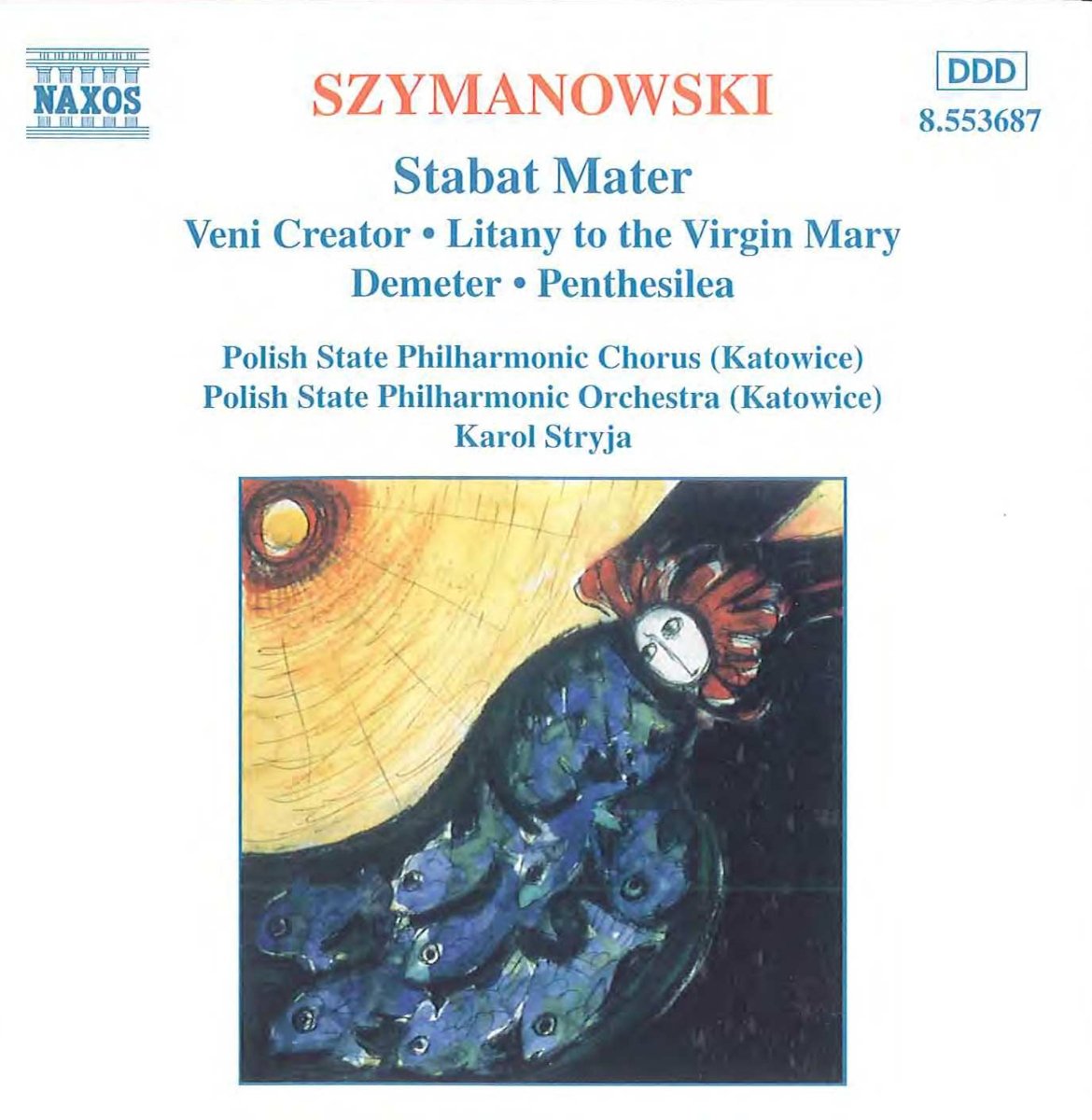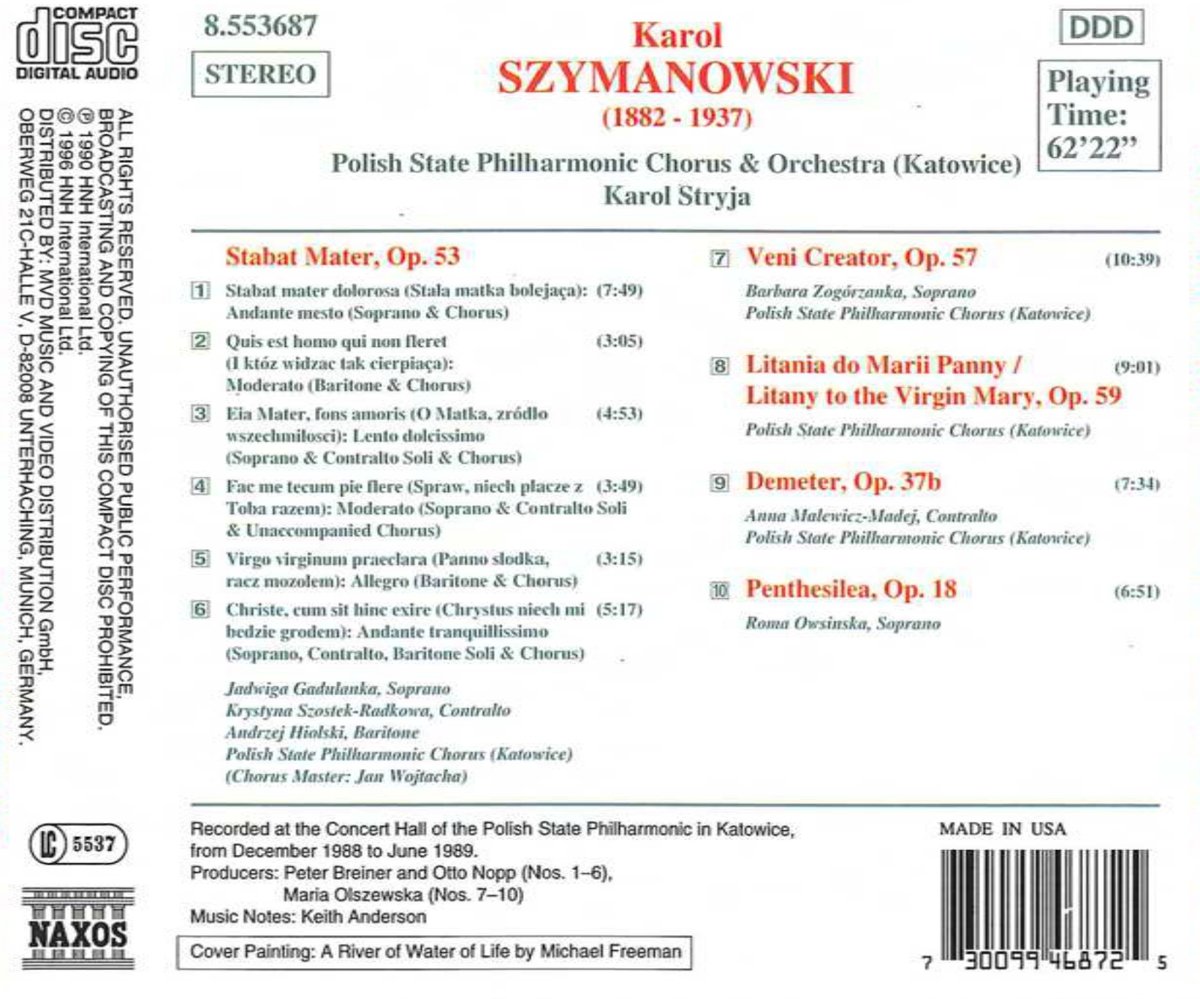
kompozytor
Szymanowski, Karol
tytuł
SZYMANOWSKI: Stabat Mater, Veni Creator
wykonawcy
Hiolski, Andrzej;
Malewicz Madej, Anna;
Stryja, Karol;
Polish State Philharmonic Orchestra, Katowice;
Polish State Philharmonic Chorus, Katowice;
Gadulanka, Jadwiga;
Owsinska, Roma;
Szostek-Radkowa, Krystyna;
Wojtacha, Jan;
Zogorzanka, Barbara
Malewicz Madej, Anna;
Stryja, Karol;
Polish State Philharmonic Orchestra, Katowice;
Polish State Philharmonic Chorus, Katowice;
Gadulanka, Jadwiga;
Owsinska, Roma;
Szostek-Radkowa, Krystyna;
Wojtacha, Jan;
Zogorzanka, Barbara
nr katalogowy
8.553687
opis
Szymanowski set a Polish translation of the Stabat mater over a period of two years, from 1924 to 1926 and it was given its first performance by the Warsaw Philharmonic Orchestra in 1929 under the direction of Grzegorz Fitelberg. The work calls for soprano, contralto and baritone soloists, chorus and orchestra, and makes use of traditional Polish musical ideas in its treatment of the medieval poem, integrating modern and earlier techniques. •
Szymanowski wrote his setting of the Veni Creator, in a Polish version by Stanislaw Wyspiánski, in 1930 for the opening of the Warsaw Academy of Music, of which he was the first rector. On the same occasion he was awarded a doctorate by the University of Cracow. Wyspiánski's text is a paraphrase of the Latin sequence, written in 1905 at a time when Poland was striving for national independence. The music in consequence has both a national and celebratory character, a mark of the occasion of its composition. The Veni Creator is scored for soprano solo, chorus, organ and orchestra. •
The more meditative Litany to the Virgin Mary, with words by Jerzy Liebert, was completed in 1933, when it was given its first Warsaw performance. It is based on two verses of the original seven-verse poem. Szymanowski had originally intended to set the whole poem, but later changed his mind. The first two fragments of the Litany were performed with the Warsaw Philharmonic Orchestra under Grzegorz Fitelberg on 13th October 1933 with the composer's sister, Stanislawa Korwin-Szymanowska, as soprano soloist. The first part of the work preserves the mournful character of the form of the litany, while the second includes a heartfelt prayer. The mystic character of the music is accentuated by the archaic use of parallel intervals and a relatively simple use of the orchestra. These choral works are as firmly embedded in Christian musical tradition as they are recognisably of their period, the Stabat mater more passionate and the Litany more lyrical in its use of soprano soloist, female chorus and orchestra, rising at times to a level of rhapsodic intensity. •
Demeter, with a text by Szymanowski's sister Zofia Szymanowska based on the Bacchae of Euripides, is scored for contralto soloist, female chorus and orchestra and was written in 1917 during the period of war-time seclusion at Tymoszówka. The work was re-orchestrated in 1924 and first performed in Warsaw in 1931. It was the theme of the Bacchae, with its conflict between Eastern mysticism and the more pragmatic West, that was given later expression in the opera Kró1 Roger. •
Penthesilea, for soprano and orchestra, was written in 1908 at Nervi on the Mediterranean to words taken from a scene of Wyspianski's play Achilleis. It was first performed in Warsaw in 1910 under the direction of Fitelberg and with the composer's sister as soloist. In 1912 Szymanowski re-orchestrated the work. The choice of text, dealing with the confession of love for Achilles by the Queen of the Amazons, is characteristic of the first period of the composer's creative life.
nośnik
CD
gatunek
Muzyka klasyczna
producent
Naxos
data wydania
03-02-1997
EAN / kod kreskowy
730099468725

(Produkt nie został jeszcze oceniony)
cena 58,00 zł
lubProdukt dostepny w niewielkiej ilości.
Wysyłka w ciągu 3 dni roboczych
Darmowa wysyłka dla zamówień powyżej 300 zł!
Darmowy kurier dla zamówień powyżej 500 zł!
sprawdź koszty wysyłki





































